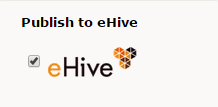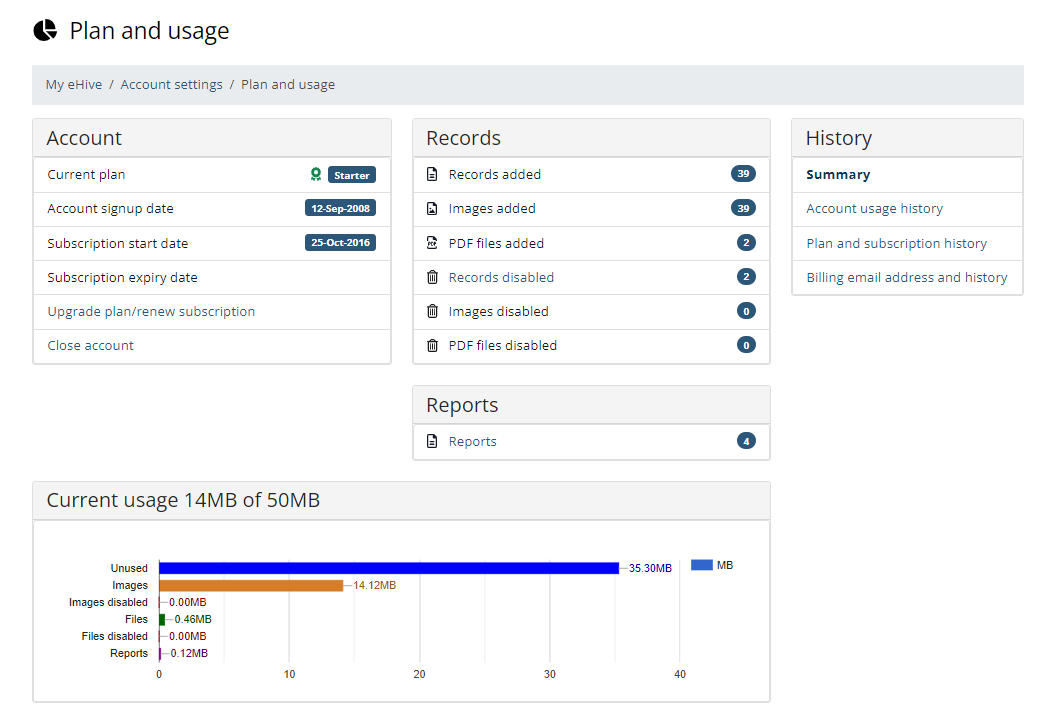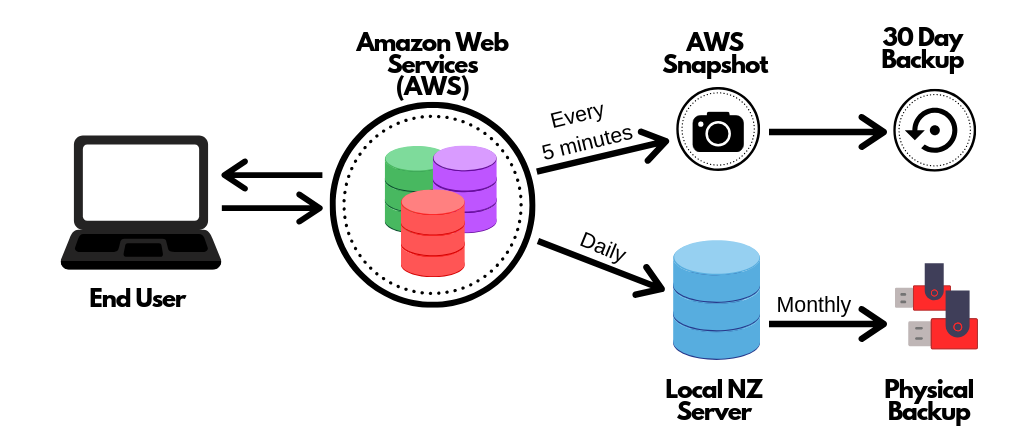eHive is a web-based collection cataloguing system developed by Vernon Systems. Go to Take a Tour to see an overview of the features of eHive. The best way to explore the system is to create a free account.
Click here to download eHive Technical Specifications:
eHive Technical Specifications (PDF 221KB)
Setting up eHive
Pricing
eHive accounts purchase a subscription for their usage on eHive either yearly or every 5 years. eHive’s subscription covers use of the software, storage and ongoing development of the product.
You can have 50MB of media storage on eHive for free with a Starter account. Each image or PDF uploaded uses the same amount as it’s file size (e.g. if the original image is 1MB, this uses 1MB of storage on eHive).
Our pricing structure breaks down the cost for each storage level for either a 1 year or 5 year subscription.
Hardware and software requirements
eHive requires a stable internet connection.
We support the latest version of all common internet browsers (Google Chrome, Microsoft Edge, Mozilla Firefox, Safari). eHive is tested on older versions, but we recommend you run the latest version of your preferred browser.
Account users
The Starter and Bronze plans include one administrator login. Multiple users can share the same login. Silver plans and above allow you to create multiple logins for different users and specific whether a login has administrator, curator (basic cataloguing functions), or viewer (read-only) access.
If users try to edit a record at the same time, the record will overwrite with each save. This means whoever saves last, makes the change to the record.
Private and public records
We understand how important it is to ensure your privacy. On eHive, you have complete control over which information you share with the public, and what records you publish.
Public users (users that are not logged in) can only view objects, images, and PDFs that have been approved for public access. Public users only have access to core descriptive fields within the object record. We will not disclose any confidential information.
When you save a record, you can decide if a record is public or private. To publish, you tick the Publish to eHive checkbox.
If you don’t want your record to be publicly visible, untick the ‘Publish to eHive’ checkbox when saving the record.
In Account Settings, you can choose if this box is ticked or unticked by default.
Testing
You can create a free account on eHive to test.
Monitoring usage
You can see how much storage your account is currently using under the Settings section > Plan and Usage.
Integration
Mobile use
eHive uses a responsive web layout that changes the display based on device’s screen dimensions. eHive can be accessed from mobile and tablet devices via any supported web browser.
We do not recommend cataloguing an object record on a mobile phone as the cataloguing screens benefit from a larger screen. Cataloguing an object can be done on a tablet.
API and WordPress
eHive has an API and WordPress plugins for embedding object records and images within a WordPress website. For more information, see http://developers.ehive.com/
Support and upgrades
Support
eHive support is based in New Zealand and the United Kingdom. Our support covers any technical issues or bugs. eHive is designed to be used with no training or support requirements. Our help can be found at https://info.ehive.com/help/
Planned outages and upgrades
eHive is designed to work 24/7. Users are notified of planned outages as a banner at the top of the page when they log into eHive. Planned outages are rare.
Upgrades are done as needed, and will not require any installation by the account users.
Security and compliance
Data ownership
You are the owner of all information (text and files) that you have uploaded to eHive. We will not give away or sell your content.
You can export all (or a subset) of your data at any time using eHive’s reporting function. Data can be exported in CSV, XLS, XML or PDF formats
eHive does not store credit card information or personal information.
Vernon Systems has a source code escrow agreement in place. The source code of the eHive software is held by an independent agent. The source code will be released by the agent to the eHive community if Vernon Systems is no longer trading.
Closing an account
You can close your account from under the Settings > Plan and Usage menu. All content must be deleted from the account first, and we can assist you with this step if needed. Your data will still exist in our historic daily backups, but we agree to never use this data in any way.
Online payments
eHive payments are processed through Windcave. Their processes are PCI compliant. We do not access or store credit card information within eHive.
Technical liability insurance
Vernon Systems holds technical liability insurance covering claims up to $NZ15 million. The coverage includes internet liability, media Liability, and loss of information.
GDPR compliance
The General Data Protection Regulation (GDPR) (Regulation (EU) 2016/679) is a regulation by which the European Parliament, the Council of the European Union and the European Commission intend to strengthen and unify data protection for all individuals within the European Union (EU). It also addresses the export of personal data outside the EU.
Protection of personal data in New Zealand law
Vernon Systems Limited is a registered New Zealand company. New Zealand has been recognised by the European Commission as having adequate protection for personal data, allowing data to be sent from an EU country to New Zealand without any further safeguards. The European Commission statement can be found here: https://ec.europa.eu/info/law/law-topic/data-protection/data-transfers-outside-eu/adequacy-protection-personal-data-non-eu-countries_en
Personal data within eHive
eHive currently only stores people’s names. A more detailed person record data entry screen is planned, but users will be able to decide how much personal information they wish to store.
Amazon Web Services GDPR compliance
eHive relies on Amazon Web Services. AWS terms and conditions automatically includes provisions for GDPR compliance: https://d1.awsstatic.com/legal/aws-gdpr/AWS_GDPR_DPA.pdf
Security
Sign In passwords have a minimum length and must include letters and numbers. This means that simple passwords that could be easily determined cannot be used. We do not support single sign-on.
All pages are accessed using encrypted webpages (HTTPS) so that access to private images is secured in the same way as online banking systems. eHive servers are secured so that only standard web access is allowed. This prevents external access to other software and commands on the server.
Passwords are stored in an encrypted format that is not visible even with direct access to the database. Other data is not encrypted, but is protected through other barriers including:
- Server access uses Amazon Web Services two-factor authentication which relies on physical tokens that generate temporary access codes in combination with usernames/passwords.
- External root access is disabled
- Backend and middleware servers are protected through an Amazon security group so that they are only accessible from the frontend servers in our private network
- Amazon data centres are compliant with ISO 27001:2013 data security standards
In the case of a security breach Vernon Systems will attempt to contact account holders but will not be liable in any way if it is unable to contact everyone.
Backup and hosting
eHive is hosted by Amazon Web Services. Their servers are located in Virginia, United States of America.
Backup Process
eHive is backed up in multiple places:
- Amazon Web Services takes a snapshot of eHive every 5 minutes and holds those snapshots for 30 days.
- All data is stored on multiple hard disks to allow eHive to continue running in case of a hardware failure.
- Data is backed up to a different city (Auckland, New Zealand) to preserve data during an extreme event, such as a fire at the data centre.
- The entire content (text and media files) is backed up daily, weekly and monthly.
Amazon Web Services has redundant power systems, generator back up, redundant air conditioning and multiple independent connections to the internet.
